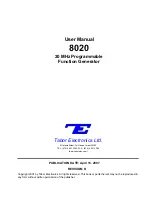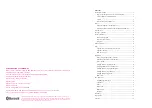
678
SIEPCYEUOQ2V01A Q2V Technical Manual
•
Motor loss increases during high slip braking. Use this function when the duty time factor is 5% ED or less and
the braking time is 90 seconds or less. The load inertia and motor characteristics have an effect on the braking
time.
•
The drive ignores the configured deceleration time during high slip braking. To stop motors in the configured
deceleration time, set
L3-04 = 1 [StallP@Decel Enable = Enabled]
and
L3-50 = 3 [StallP@Decel Mode =
HiFlux Overexcitation]
.
•
You cannot use high slip braking to decelerate deceleration at user-defined speeds. To decelerate at user-defined
speeds, use the overexcitation deceleration function.
•
You cannot accelerate the motor again during high slip braking until you fully stop the motor and input the Run
command again.
•
You cannot use high slip braking and the KEB Ride-Thru function at the same time. If you enable those two
functions, the drive will detect
oPE03 [Multi-Function Input Setting Err]
.
■
Overexcitation Deceleration
Overexcitation deceleration quickly decelerates motors without braking resistors. This lets you stop a motor more
quickly than with the ramp to stop processes.
Overexcitation deceleration increases excitation current during deceleration to cause a large quantity of braking
torque through motor overexcitation. You can set the deceleration speed to adjust the deceleration time for
overexcitation deceleration. Overexcitation deceleration lets you accelerate the motor again during deceleration.
Enter the Run command during overexcitation deceleration to cancel overexcitation deceleration and accelerate
the drive to the specified speed.
To enable this function, set
L3-04 = 1 [StallP@Decel Enable = Enabled]
and L3-50 = 3, 4 [StallP@Decel Mode
= HiFlux Overexcitation, HiFlux2 Overexcitation].
When
L3-04 = 4
, the motor will decelerate for the
Deceleration Times [C1-02, C1-04, C1-06, or C1-08]
. If the
drive detects
ov [Overvoltage]
, increase the deceleration time.
When
L3-04 = 5
, the drive uses the value in
C1-02, C1-04, C1-06, or C1-08
to decelerate and it adjusts the
deceleration rate to keep the DC bus voltage at the level set in
L3-17 [DCBus Regul.Level]
. The load inertia and
motor characteristics have an effect on the braking time.
Notes on Overexcitation Deceleration
•
Do not use Overexcitation Deceleration with a braking resistor.
•
Do not use Overexcitation Deceleration for these applications. Connect a braking resistor to the drive as an
alternative to Overexcitation Deceleration.
–
Frequent sudden decelerations
–
Continuous regenerative loads
–
Low inertia machines
–
Machines that have no tolerance for torque ripples
•
Motor loss increases during overexcitation deceleration. Use this function when the duty time factor is 5% ED
or less and the braking time is 90 seconds or less. The load inertia and motor characteristics have an effect on
the braking time.
•
You can use overexcitation deceleration in OLV control, but this control method decreases the precision of
torque control and braking efficiency. Use V/f control for the best results.
•
The drive disables these functions during braking with Overexcitation Deceleration 2:
–
Hunting Prevention Function (V/f Control)
–
Torque Limit Speed Control (OLV Control)
■
n3-01: HSB Dec Freq Width
No.
(Hex.)
Name
Description
Default
(Range)
n3-01
(0588)
Expert
HSB Dec Freq Width
Sets the amount by which the output frequency is to be lowered during high-slip braking, as a
percentage of
E1-04 [Max Output Frequency]
, which represents the 100% value.
5%
(1 - 20%)
When you must detect
ov [DC Bus Overvoltage]
during high-slip braking, set this parameter to a large value.
V/f
OLV
OLV/PM
OLV/PM AOLV/PM
EZOLV
Summary of Contents for Q2V Series
Page 2: ...This Page Intentionally Blank 2 SIEPCYEUOQ2V01A Q2V Technical Manual...
Page 12: ...12 SIEPCYEUOQ2V01A Q2V Technical Manual...
Page 18: ...i 2 Legal Information 18 SIEPCYEUOQ2V01A Q2V Technical Manual...
Page 26: ...1 2 Features and Advantages of Control Methods 26 SIEPCYEUOQ2V01A Q2V Technical Manual...
Page 38: ...2 8 Installation Methods 38 SIEPCYEUOQ2V01A Q2V Technical Manual...
Page 70: ...3 3 Main Circuit Wiring 70 SIEPCYEUOQ2V01A Q2V Technical Manual Models B006 B012...
Page 102: ...3 17 Motor Application Precautions 102 SIEPCYEUOQ2V01A Q2V Technical Manual...
Page 138: ...4 12 Test Run Checklist 138 SIEPCYEUOQ2V01A Q2V Technical Manual...
Page 144: ...5 2 European Standards 144 SIEPCYEUOQ2V01A Q2V Technical Manual...
Page 145: ...Standards Compliance 5 5 2 European Standards SIEPCYEUOQ2V01A Q2V Technical Manual 145...
Page 146: ...5 2 European Standards 146 SIEPCYEUOQ2V01A Q2V Technical Manual...
Page 266: ...7 10 Troubleshooting Without Fault Display 266 SIEPCYEUOQ2V01A Q2V Technical Manual...
Page 284: ...8 6 Storage Guidelines 284 SIEPCYEUOQ2V01A Q2V Technical Manual...
Page 312: ...10 10 Peripheral Devices and Options 312 SIEPCYEUOQ2V01A Q2V Technical Manual...
Page 430: ...11 21 Parameters Changed by PM Motor Code Selection 430 SIEPCYEUOQ2V01A Q2V Technical Manual...
Page 731: ...SIEPCYEUOQ2V01A Q2V Technical Manual 731 Z Z pulse Auto Tuning 125...
















































